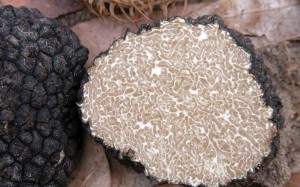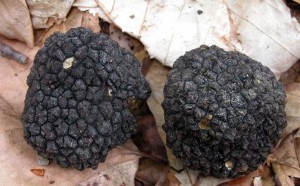Black Truffles
Burgundy Black Truffles of Europe – Tuber Uncinatum
Synonyms:
Tuber uncinatum Chatin, C. R. hebdom. Acad. Sciences 104: 1132 (1887); La truffe 55, t. 7 f. 1 a-e
Macroscopic characters:
Ascomata: hypogeous, subglobose, sometimes basal cavity, 2-9 cm, blackish-brown to black, conspicuously warted. Warts 3-9 mm across, usually smaller than those observed in Tuber aestivum, pyramidal, 4-6-sided, vertically fissured, sometimes whith transversal striation.
Gleba: firm, solid, white when immature, becoming dark brown at maturity, darker than Tuber aestivum gleba, marbled with numerous, thin, white, meandering, branching veins that do not change colour when exposed to the air.
Odour: of medium intensity, stronger than Tuber aestivum odour, different, sometimes phenolic and and unpleasant when very ripe.
Taste: of medium intensity, stronger than Tuber aestivum taste, nutty.
Habitat
Tuber uncinatum grows always in shady places (Tuber aestivum usually in sunny places). It is the most frequent edible truffle in Europe. Their period of ripeness is from October through January. Tuber uncinatum are associated with the roots of several trees: oaks (Quercus), beeches (Fagus sylvatica), poplars (Populus), hazels (Corylus), pines (Pinus) and lindens (Tilia).
Notes:
Molecular analysis showed no differences between Tuber aestivum and Tuber uncinatum. Differences in taste, odor and spore morphology are because of ecological factors.

